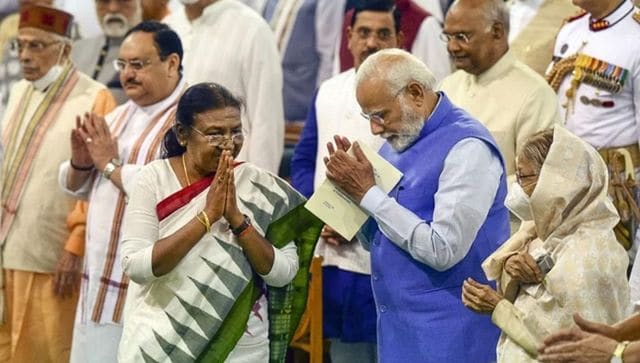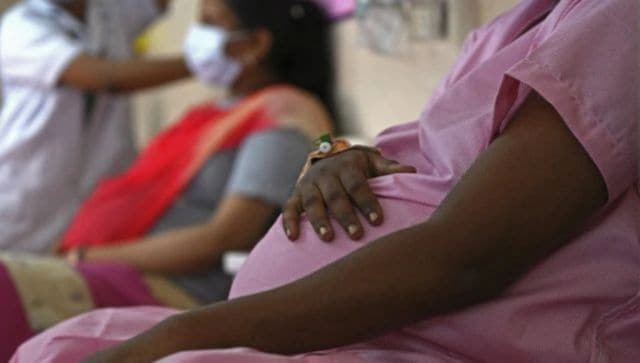India witnessed many big changes in 2022.
In its 75th year of Independence, India got its first tribal President in Droupadi Murmu, the country bolstered its defence sector and took a step towards securing the bodily autonomy of women.
Before we bring down the curtain on the year, let’s cast a look back at how India progressed in 2022.
India’s first tribal president
India scripted history when Murmu was elected as the country’s first president from the tribal community.
64-year-old Murmu hails from the Mayurbhanj district of Odisha and belongs to the Santhal tribe.

In July, the National Democratic Alliance (NDA) presidential nominee won with an overwhelming majority by bagging 64.03 per cent of the electoral college votes, defeating the Opposition candidate Yashwant Sinha who secured 35.97 per cent votes.
On the 25 July, the former Jharkhand governor was sworn-in oath as India’s 15th President, becoming just the second woman ever to hold the country’s highest constitutional post.
New beginnings
On 1 December, India assumed the G20 presidency for a year.
The Group of 20 (G20) is an intergovernmental forum comprising the world’s major developed and developing economies. Its members represent more than 80 per cent of the global GDP, 75 per cent of international trade and 60 per cent of the world population.
India has planned more than 200 events in over 50 cities across the country during its presidency of the influential bloc till 30 November, 2023.
The G20 summit next year in September “would be one of the highest profile international gatherings to be hosted by India,” the Press Information Bureau (PIB) had said in a press release earlier.
A step away from the colonial past
The month of September brought a number of sea changes for India.
Shedding its colonial past, India got a new Naval Ensign (flag).
The new ensign was unveiled at Cochin Shipyard Limited in Kerala’s Kochi on 2 September by Prime Minister Narendra Modi.
In the new design, the Tricolour is placed on the upper canton or the top left of the flag, and on the right, there is a blue octagon encompassing the national emblem that sits atop an anchor, depicting steadfastness, the Navy stated.
“The octagonal shape with twin golden borders is inspired from the seal of the great Indian emperor, Chhatrapati Shivaji Maharaj, whose visionary maritime outlook established a credible naval fleet,” the armed force said in a video.
The previous sign included a red Saint George’s Cross with the Tricolour in the canton or top left corner of the flag. The emblem of India was superimposed on the intersection.
In September, the iconic Rajpath, which stretches from Rashtrapati Bhavan to India Gate, was renamed Kartavya Path (Path of Duty).
The revamped Kartavya Path boasts of red granite walkways surrounded by greenery, renovated canals, state-wise food stalls, amenity blocks and vending kiosks.
The government said the new name symbolises a shift from the erstwhile Rajpath being an “icon of power” to Kartavya Path representing “public ownership and empowerment”, as per Outlook.
On 8 September, Modi inaugurated the newly-christened Kartavya Path as well as unveiled the 28-foot statue of Netaji Subhas Chandra Bose at India Gate.

The statue is carved from a monolithic block of granite weighing 280 metric tonnes, which was sourced from Khammam in Telangana.
Top court upholds choice for women
In one of its significant rulings to date, the Supreme Court extended the right to safe and legal abortion up to 24 weeks of pregnancy to all women regardless of their marital status.
On 29 September, the apex court said that a distinction cannot be made between married and unmarried women under the abortion law in India, adding that it is the “right of every woman to make reproductive choices without undue interference from the state”.

A bench comprising Justices DY Chandrachud, AS Bopanna and JB Pardiwala also said that the meaning of rape must include marital rape for the purpose of the Medical Termination of Pregnancy (MTP) Act.
“Law in modern times is shedding the notion that marriage is a precondition for the rights of persons. The MTP act must consider the realities of today and must not be restricted by old norms. The law must not remain static and must keep in mind changing social realities,” the apex court said in a landmark judgment.
India’s defence forces strengthened
The defence sector was also further bolstered.
In September, Prime Minister Modi commissioned country’s first indigenous aircraft carrier INS Vikrant into the Indian Navy at Cochin Shipyard Limited.
The INS Vikrant is 262 metres long and 62 metres wide with a capacity to hold 30 fighter planes and helicopters. Around 76 per cent of the ship’s parts have been built indigenously by employing 500 Indian firms, BBC reported.
Equipped with state-of-the-art features, INS Vikrant was constructed at an approximate cost of Rs 20,000 crore.
With its commission, the Indian Navy has solidified its position as a ‘blue water navy’, a maritime force that can operate in national as well as the world’s deep, vast oceans.
The central government’s Atmanirbhar Abhiyan expanded to the Indian Air Force as it inducted made-in-India Light Combat Helicopter, Prachand, in October.
Prachand is the first indigenous multi-role combat helicopter armed with ground attack and aerial combat capability. “It possesses modern stealth characteristics, robust armour protection and formidable night attack capability”, the Ministry of Defence said in a statement.
On the night of 15 December, India successfully carried out trials of the Agni V nuclear-capable ballistic missile.
Developed by Defence Research and Development organisation (DRDO), the long-range surface-to-surface missile can attack targets at ranges of 5,000 to 5,500 km.
Digital boost
India joined the league of nations with their own centralised digital currencies this year.
A Central Bank Digital Currency (CBDC) is a virtual form of currency issued by a central bank that can be used for contactless transactions.
The Reserve Bank of India (RBI) launched the pilot phase for retail Digital Rupee or e₹-R, India’s CBDC, on 1 December in four cities – Mumbai, New Delhi, Bengaluru and Bhubaneswar.
A closed user group (CUG) consisting of participating customers and merchants in these cities can use the e-rupee or digital rupee.
Currently, four banks – State Bank of India, ICICI Bank, Yes Bank and IDFC First Bank – have been roped in for the project. Four more banks, including Bank of Baroda, Union Bank of India, HDFC Bank and Kotak Mahindra Bank, will be added gradually.
India also made advances in the telecom sector by rolling out 5G services in the country.
In October, the prime minister inaugurated 5G services at India Mobile Congress (IMC) 2022.
5G technology is expected to deliver ten times better download speed in comparison to 4G and up to three times higher spectrum efficiency, Indian Express said in its report.
Major telecom brands such as Reliance Jio and Bharti Airtel have rolled out 5G services across select cities so far.
First private rocket
With the launch of Vikram-S – India’s first private rocket – in November, New Delhi joined the list of nations whose private space agencies are capable of building and launching rockets.
Developed by Hyderabad-based start-up Skyroot Aerospace, the six-metre tall launch vehicle Vikram-S has marked the successful entry of the private sector into India’s space industry.
This accomplishment bears testimony to the immense talent of our youth, who took full advantage of the landmark space sector reforms of June 2020. @SkyrootA pic.twitter.com/5M8hqG2cqD
— Narendra Modi (@narendramodi) November 18, 2022
According to PTI, Vikram-S is “one of the world’s first few all-composite rockets that has 3-D printed solid thrusters for spin stability”.
A common entrance test for college students
The University Grants Commission (UGC) made the Common University Entrance Test (CUET) mandatory for students seeking admission to any central university in the country.
The CUET will “provide a common platform and equal opportunities to candidates across the country. A single examination will enable the candidates to cover a wide outreach and be part of the admissions process to various central universities,” the National Testing Agency (NTA) had said earlier.
With inputs from agencies
Read all the Latest News, Trending News, Cricket News, Bollywood News,
India News and Entertainment News here. Follow us on Facebook, Twitter and Instagram.
from Firstpost India Latest News https://ift.tt/iAJc764
No comments:
Post a Comment